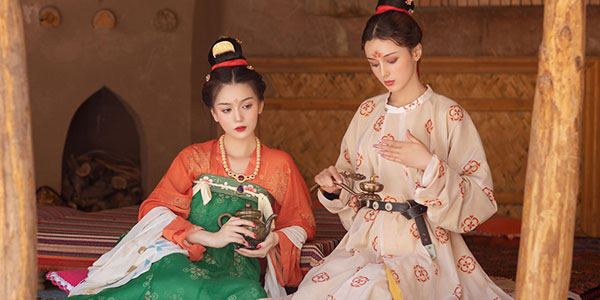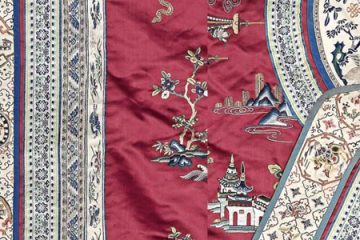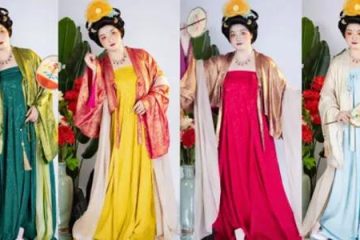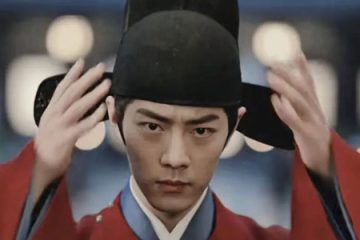Across Millennia: The Allure of Tang Hanfu’s Evolution

The Tang Dynasty was the peak of China’s feudal society. Back then, both people’s thinking and material production reached historic heights. Tang dynasty clothing fashion, evolving dramatically across nearly three centuries, showcased unparalleled diversity in silhouette, color, and ornamentation, moving from restrained elegance to opulent grandeur and nostalgic revival, embodying the dynasty’s spirit of openness and cultural confidence. Its legacy continues to inspire contemporary fashion and cultural revival worldwide.
Ⅰ. Early Tang Dynasty
The Early Tang period favored subtle refinement. Women wore slim-sleeved, short jackets paired with high-waisted skirts tied just below the bust. Fabrics were often light silks in soft hues, emphasizing understated beauty. Narrow stripes on skirts, known as “Jianse Qun (间色裙),” were initially modest.

The popularity of such narrow-sleeved, short garments came from influences of clothing styles of groups like the Turks, Persians, and Tibetans.
For women’s wear, skirts had high waistlines tied above the chest. Trendy styles included gradient-colored skirts—made by stitching strips of two or more colored fabrics, each narrower at the top and wider at the bottom.
Beyond dresses, another popular look was layering a “banbi” (半臂,a short-sleeved Tang dynasty clothing) over the top for extra charm.

The “pibo“(披帛)—a light, soft long scarf—was also in vogue, draped over shoulders and looped around the chest.
Overall, women’s fashion then favored a slim, elegant look with a modest style.
Ⅱ. Wu Zhou Period
In the late early Tang Dynasty, as Wu Zetian (武则天) gradually took power and began ruling from the imperial court, women’s fashion in the Tang Dynasty shifted accordingly.
Skirt waists rose to a high position just below the chest. Blouses featured curved necklines that formed a round collar across the chest, creating the distinctive low-cut look of Tang dynasty clothing.

Styles grew bolder and more open: skirt panels became extremely fine, even numbering 40 or 50. Multicolored striped skirts were gradually replaced by long skirts in solid, vibrant hues.
Along with these style changes, a new type of skirt called “mofu” (陌腹) emerged—a short skirt worn separately over other garments.

Even after the end of Wu Zetian’s reign, noble women remained highly engaged in politics. Some even wore blouses un-tucked from their skirts, or adopted male attire. These daring fashion choices still shape our imagination of the sartorial freedom in Tang society today.
Ⅲ. Prosperous Tang Dynasty
The Prosperous Tang, under Emperor Xuanzong (唐玄宗), celebrated voluptuousness. Sleeves widened dramatically, and skirts ballooned in size. The veiled “Wei Mao” (帷帽) hat shed its gauze. Consort Yang Yuhuan (杨玉环) popularized lavish styles like the “Tear Makeup” and “Wine-Flush Makeup.” Tang dynasty clothing became extravagantly decorated.
By this time, the Tang Dynasty was at its peak—prosperous and peaceful. Women’s figures grew fuller, and their clothing became slightly looser. The aesthetic for attire shifted to what we now know as “appreciating plumpness as beauty.”


Thanks to advances in silk craftsmanship and a wide range of silk products, lightweight, sheer fabrics grew popular among women. With shoulders and arms faintly visible beneath—never fully exposed—they exuded a subtle, understated beauty of the body.
Ⅳ. Mid-Tang Dynasty
The An Lushan Rebellion marked a turning point, as the Tang Dynasty shifted from prosperity to decline. In the Mid-Tang period, all social classes sought to heal the wounds it left.
In fashion, tight “foreign-style” clothing was completely abandoned, and wide sleeves became popular—their cuffs two to three times wider than those in the Early Tang.

Later, a trend of luxury and indulgence emerged, with palace women and commoners alike vying to wear more hair ornaments. It’s also a sort of escaping reality.
Ⅴ. Late Tang Dynasty
In the late Tang Dynasty, most skirts had wide, long hems. Women began adding a panel of the same patterned fabric as the skirt to the waistband. The zhiyi (翟衣, a formal ceremonial robe) evolved into a long, loose-sleeved outer garment—reaching the length of the body, with a straight down collar, light in weight and free of elaborate ornamentation.

As formal attire became part of daily life, that era of women’s bold confidence and graceful allure finally left its radiance etched in the night sky of history.
Summary
Tang dynasty clothing was a dynamic social canvas. Its evolution – from Early Tang restraint to High Tang exuberance and post-rebellion retrospection – mirrored the dynasty’s political climate, economic power, and cultural exchanges. The daring adoption of male attire by women signaled shifting gender norms and a loosening of rigid Confucian codes. The explosion in textile patterns, dyes, and imported motifs vividly illustrated Tang’s cosmopolitanism and thriving Silk Road exchanges.
Poets like Li Bai (李白) immortalized this beauty: “Seeing her cloud-like dress, one thinks of blooming flowers; Spring breezes brush the rail, dew-laden splendor.” The intricate cuts, radiant hues, and symbolic richness of Tang dynasty clothing captured an era of unmatched brilliance. They remain a dazzling thread in the tapestry of Chinese civilization.



0 Comments